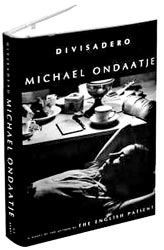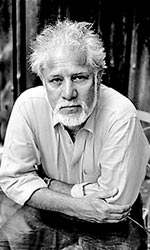
A poet charts the novel for our new centuryDivisadero by Michael Ondaatje. Bloomsbury, London, 2007. Reviewed by Ernest MacIntyre The 1914-18 war may well mark the far end of the medieval European world in terms of transport as well as pristine countryside. At least it does in Michael Ondaatje’s new novel Divisadero. Near the end of the book and the war, a train to Paris is mentioned. Up till then the story of the long last part of the novel, about Lucien Segura, a French writer of years long gone, is literally transported on horses and horse drawn carts in many absorbing sub-stories which engage streams, fields, wooded places, farm houses and medieval church steeples in south central France. But the first part of the book, with different characters and story is in California just about twenty years before the first Gulf War of 1991.Yet the two worlds so far apart in time and place are the same story .The name Divisadero Street, San Francisco which stands there right now, tells us why.
In Petuluma country, California, a terrible massacre of the Cooper family leaves only a little boy of four hiding under the floorboards. He is ‘adopted’ by the neighbour for training as a farmhand. The farm owner’s only child Anna is born soon after, the mother dying in the act. The father adopts another infant Claire, from the same hospital, whose mother also died at childbirth during the same time. The Cooper child becomes ‘Coop’, a brother. Up to a point in the story we think he is also ‘a son’. When he is about twenty, and becomes Anna’s lover, it provokes a terrifying and seemingly senseless act of violence by the father, breaking up the ‘family’ and scattering it in all directions. Coop escapes to the card tables of Lake Tahoe where he finds new companions, some like Dorn and Ruth, compassionate and enduring, and others so violent, that they brutally clean him out, even of all of his memory. Anna escapes from her father and eventually goes across the Atlantic, to the countryside of France. She absorbs herself in researching and re-creating the dead Lucien Segura. Claire who works for a Public Prosecutor returns to the father’s farm at week ends. She seeks solitude riding in the woods. She is the only one of the trio to continue contact with the old man, unexplained except for retrospective compassion by Anna that “there must have been some fearful grains of love for me”. After she has moved from California to the countryside of south central France, Anna says, “I come from Divisadero Street … between San Francisco and the fields of the Presidio”. The Presidio at the tip of the San Francisco peninsula, with its historic sense of place, fields, and wooded hills is suggestive of the old world, perhaps even of the French countryside of the late nineteenth and early twentieth centuries, from which Anna creates most of the art about Lucien Segura.
Divisar also means ‘to gaze at something from a distance’, and it is from a time long past, through Lucien Segura, that Anna looks into the present and future distances for those she has lost and wonders about. It is from this structural aspect of the novel that the reader may get the impression, of two separate novellas, the large, “latter”, more or less continuous one about Lucien Segura of about say, 1875 to about 1925 and the other “earlier“, apparently shorter, card pack shuffled arrangement of what happened to Claire, Coop, Anna and their old man between about 1970 and about 2002. Ondaatje easily lets happen the functional two- novella effect by deftly closing off the visible story of Claire, Coop and the father followed by making Anna invisible once she has got the story of Lucien Segura moving. We then get absorbed by a whole lot of the many parts of the Segura story, each part a story by itself. Each of these stories of poetic economy can literally be scissored out from the pages, pasted and framed as separate independent ones too. So can the stories from the earlier story of Anna, Coop and Claire. Ondaatje may even be hinting at this structure through the later voice of Anna referring to the seminal incident of the novel as “something that might occur within just a square inch or two of a Breughel.” The painter Breughel who caught the attention of the early twentieth century German makers of the ‘epic’ form in dramatic literature. It is thus a novel with an effective episodic structure which combined with its poetic narration conditions the reader away from any tendency to be dragged emotionally towards one or more characters. It nearly happened to me with Coop when I saw him for the last time, as he, movingly but without memory, takes the correct turn, driving past a tree of his childhood, towards his old home.‘Epic’distancing, perhaps divisar again, makes the experience total. But Ondaatje’s own master craftsmanship goes beyond the ‘epic’. For to reason that because Lucien Segura is unearthed and told by Anna , time wise his story is a result of the” primary” California farm story, is of no value in experiencing this novel. Daringly Ondaatje has pulled off in art what some scientists have popularized for the general reader, that linear demarcation of events is a practical convenience for everyday life and our brief existences. That the way time is really constituted is something else. And yet the wars of the world concede to the traditional reader some well spaced time markers. Vietnam, the first Gulf war, the second Gulf war, the 1914-18 war. This function though is probably secondary to aligning the community violence suffered by Ondaatje’s characters alongside America’s reach across the world. Far away big wars come through, just so and no more, enough to allow the reader’s imagination to make the connection. In one very moving intimate scene the novelist fantastically juxtaposes a war long before the birth of the USA with the Gulf War of 2002. After an earlier Coop episode in which “One of the great high-tech massacres of the modern era” in 1991 Iraq is shown, significantly through the ubiquitous TV war screens of our evenings, we meet Coop twelve years later, the individual victim of local brutality that removed his memory. He is induced by the caring Dorn and Ruth to join their community’s medieval costume festival when America was poised to attack Iraq again. Ruth was hearing about America bombing a civilian city, and indicating Coop says, “Look at your friend, even he’s not innocent. No one here is. Not me. Not you. Not even you. We’re the barbarians too. We keep letting this happen.” She goes up to him, crying. “Dance with me Coop will you? “. He puts his arms up and she moves gently in against him, remembering the results of the local barbarity on his body and mind. The writer then collapses time in the theatre of the imagination even while he aligns the local to the international. Children and adults come onto the floor in their fourteenth century European village costumes. Medieval monks carry anti American-war placards as if at an outbreak of the centuries old European hundred years war. Nietzsche stands as a portal to this novel. “We have art so that we shall not be destroyed by the truth”. Anna’s art laying out the story of Lucien, Lucien’s art re-creating in fiction the love of his life, Marie-Neige, the weekend ‘solitude’ of Claire in the woods near her childhood home. Coop was adept in the physical world but outside the sphere of language. Had he still possessed memory when we last saw him he too could have found his saving in the creations of ‘solitude’. He is the only one, artless, that my heart went out to. Overarching them all is Ondaatje’s art, magical poetic transportation on words, phrases, paragraphs and sub-stories, so that our reading shall not be destroyed in the technical structures of the novel. We swim along compulsively atop a stream of reading ; the originality and structural ingenuity of the work moves underneath. Its depth and complexity surface upon you almost unnoticed, quite gradually. |
|| Front
Page | News | Editorial | Columns | Sports | Plus | Financial
Times | International | Mirror | TV
Times | Funday
Times || |
| |
Copyright
2007 Wijeya
Newspapers Ltd.Colombo. Sri Lanka. |

